
|
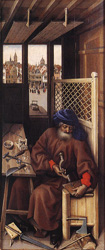 |

|
 |
Excerpt from Meyer Schapiro, "'Muscipula Diaboli,' The Symbolism of the Mérode Altarpiece," repr. in Late Antique, Early Christian, and Mediaeval Art: p. 1: In the Mérode Altarpiece by the Master of Flémalle, the figure of Joseph appears in a wing beside the Annunciation as an artisan who fashions mousetraps.... [T]his detail of the mousetrap is more than a whimsical invention of the artist, suggested by Joseph's occupation. It has also a theological meaning that was present to the minds of Christians in the Middle Ages, and could be related by them to the sense of the main image of the triptych. St. Augustine, considering the redemption of man by Christ's sacrifice, employs the metaphor of the mousetrap to explain the necessity of the incarnation. The human flesh of Christ is a bait for the devil who, in seizing it, brings about his own ruin. "The devil exulted when Christ died, but by this very death of Christ the devil was vanquished, as if he had swallowed the bait in the mousetrap. He rejoiced in Christ's death, like a bailiff of death. What he rejoiced in was then his own undoing. The cross of the Lord was the devil's mousetrap; the bait by which he was caught was the Lord's death...."
/p. 2: The connection of the mousetrap in the picture with the theological metaphor is strengthened by the extraordinary way in which the artist has rendered the Annunciation in the neighboring panel. Instead of the Holy Spirit in the form of a dove, usual in images of the subject, he has represented a tiny naked figure of a child bearing a cross and descending toward the Virgin along the beams of light which have just passed through a window.... [T]he child was probably understood by the pious spectator as a symbol of the incarnation to come, just as the cross carried by this figure symbolized the Crucifixion and Redemption. Here, too, as in the Joseph scene, doctrine, metaphor, and reality are condensed in a single object. The /p. 4 beams of light penetrating the window are not simply a phenomenal detail of everyday life, which later Dutch artists were to represent more subtly and picturesquely in their genre paintings of a woman reading or sewing in her room; the passage of the rays through the glass is a characteristic mediaeval image of the miraculous insemination and birth. In mediaeval poetry, in mystical literature, in hymns and mystery plays, in Latin and the vernacular, this simile recurs:
|
As a ray of the sun Through a window can pass. And yet no hurt is done The translucent glass So, but more subtly, Of a mother untried, God, the son of God, Comes forth from his bride. |
/p. 5: In the first decades of the fifteenth century, the leaders in the movement for the cult of Joseph were two eminent conservative reformers of the Church who had held important religious posts in Flanders, the Cardinal Peter d'Ailly (1350-1425), Bishop of Cambrai, a diocese that embraced Hainaut, Brabant, and Namue, and his pupil, John Gerson (1363-1429), who for a time after 1397 was dean of St. Donatian in Bruges. At the Council of Constance in 1416, they proposed that Joseph be elevated to a rank above that of the apostles and next ot the Virgin's; they argued also for the institution of a universal feast of the Marriage of Mary and Joseph. Their effort was unsuccessful, but it contributed, no doubt, to the growth of the cult of Joseph....
Gerson's account of Joseph is not irrelevant to this detail of the Mérode panel. In the first place, he stresses Joseph's occupation as a carpenter .... /p. 6 [H]e disserts at length on the virtue of this humble craft which, together with the Virgin's labor as a weaver, assures his humility, his moral dignity, and livelihood:
| O what a marvel of deep humility --thus God's graciousness and humanity was such that he willed to be subject ot a carpenter, a charlier or woodcutter, and to a poor weaver or silk worker. [Joseph] devoted himself to work and toil, so as to be busied well and earn a just and honest living, and gain the blessing the Prophet speaks of when he says: 'Because you eat the toil of your hands (that is, what your hands earn) you are blessed and it will go well with you (Psalm 127).' Thus Joseph in youth took to carpentry, to making carts or sheds or windows or ships or houses, though he was of an honorable and noble line in Nazareth, contrary to the men and women who don't want to work and think it shameful or slavery, and so are often poor and evil in the world and more to God, for such persons are commonly slaves to all the vices.... |
These arguments... anticipate the ascetic Protestant concept of the vocation and the religious value of industriousness, and should be taken into account in the problem of the origins of the Protestant ethic and bourgeois morality....
Significant parallels to the imagery of the Mérode Altarpiece can be found in the Hours of Catherine of Cleves, a manuscript made in the northern Netherlands about 1440. For example, the following page from this manuscript shows the same naked Christ Child bearing the Cross found in the Mérode altarpiece while the image in the bas de page shows a fisherman using a baitbox:

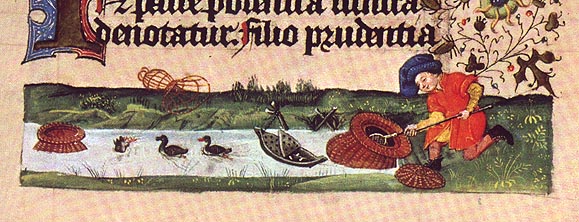
In another article published in 1959, Meyer Schapiro identified the board with holes Joseph is working on with the lid of the baitbox. Christ as bait is found in another bas de page showing the baby Christ sitting as bait in a trap being set by the baby John the Baptist:

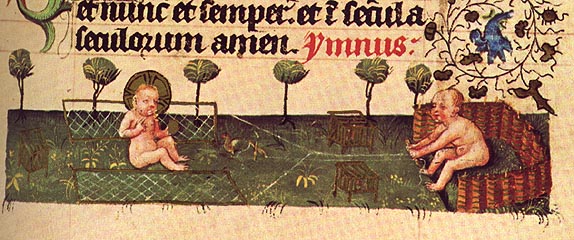
Other miniatures in the Hours of Catherine of Cleves have been used by scholars to make different identifications of the object Joseph is working on. For example, the spikeblock tied around the waist of Christ in the Carrying of the Cross has been suggested as a possible identification:
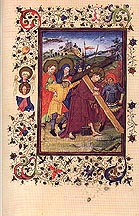
Another suggestion has been to see the board as a strainer for a winepress. A bas de page image in the Hours of Catherine of Cleves shows Christ in a winepress:
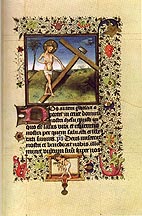

Several of the miniatures in the Hours of Catherine of Cleves parallel the Mérode Altarpiece's emphasis on the identification of Mary and Joseph as artisans:

Compare the conception of Joseph in earlier art to that found in the Mérode Altarpiece. For example see Joseph in the Flight into Egypt in Melchoir Broederlam's Dijon Altarpiece or in an early fifteenth century Book of Hours in the Walters Art Museum (Walters 265)
The pitcher on the table can be identified as a popular type of Florentine ceramics ware which was noted for its characteristic blue cobalt oak leaf decoration. On the left side of the pitcher in the painting can be seen what is probably a bird similar to the one in the Metropolitan's jug. On the right hand side can be seen pseudo-kufic letters. The pitcher in the Merode Altarpiece comes particularly close to those associated with Giunta di Tugio who was the most important maiolica ceramist of his time in Florence. Giunta was trained in his father's workshop which he took over and ran for thirty years after his father's death in 1419. Consider the social and economic implications of including this detail in the painting. Remember the contrast to the types of objects included in works associated with the nobility.
Other Works associated with Robert Campin
Robert Campin, Madonna and Child, from the Flémalle Altarpiece, c. 1430-34.
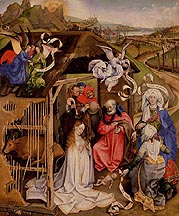
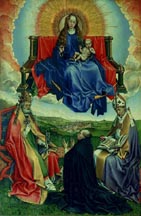
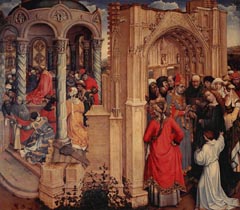

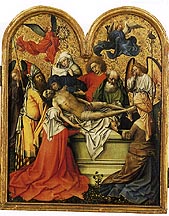

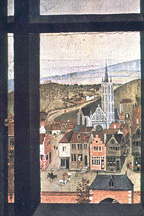
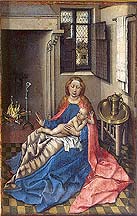
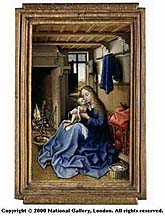

Robert Campin, Portrait of a Man, c. 1425-30, London, National Gallery
Robert
Campin, The Werl Altarpiece. Painted in 1438 for Heinrich von Werl. |
|